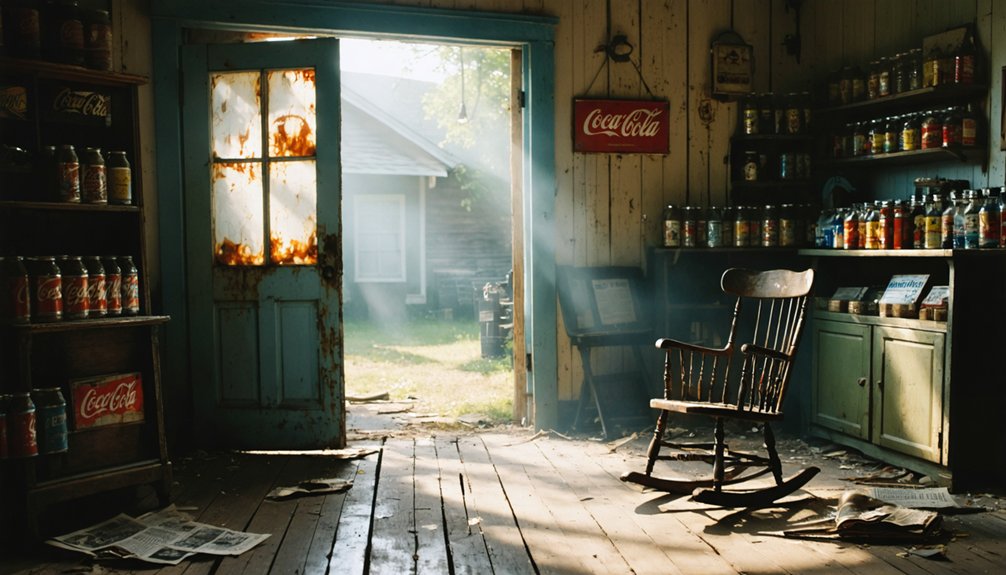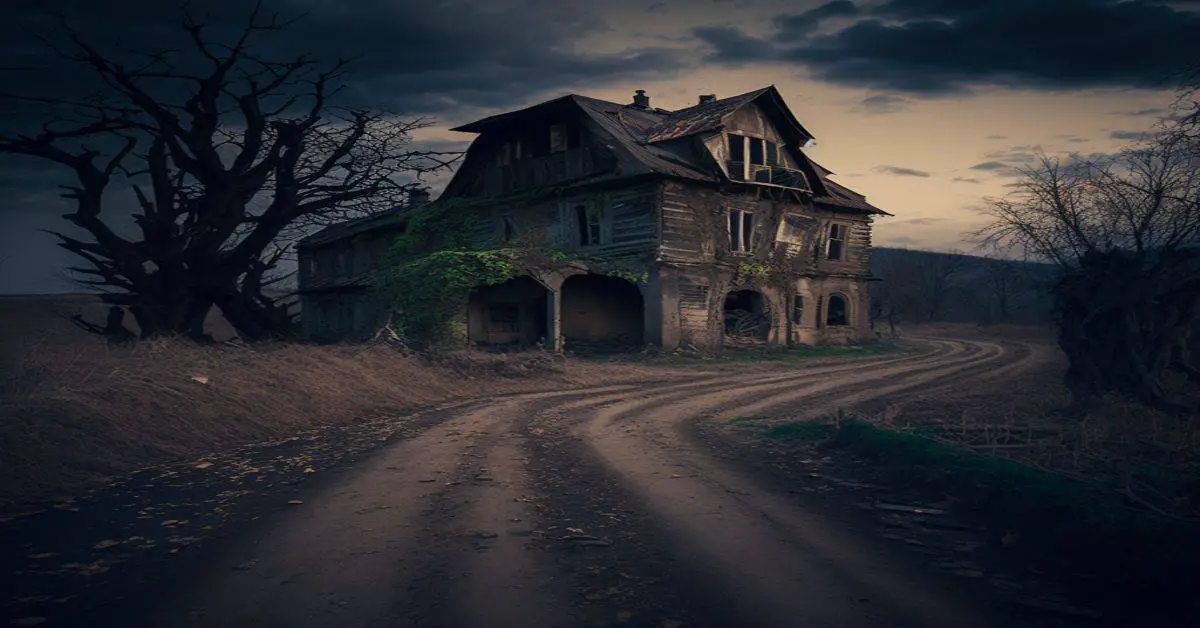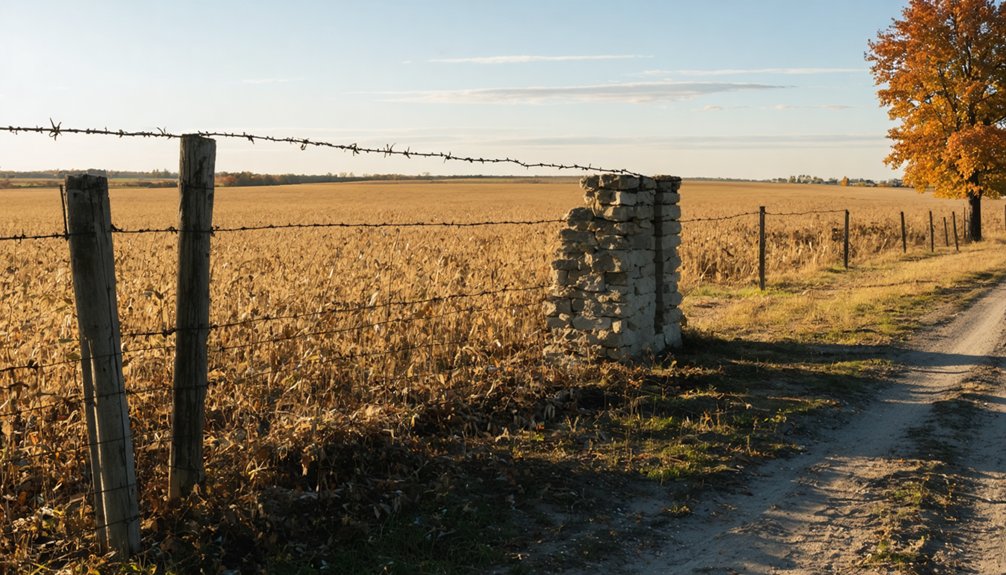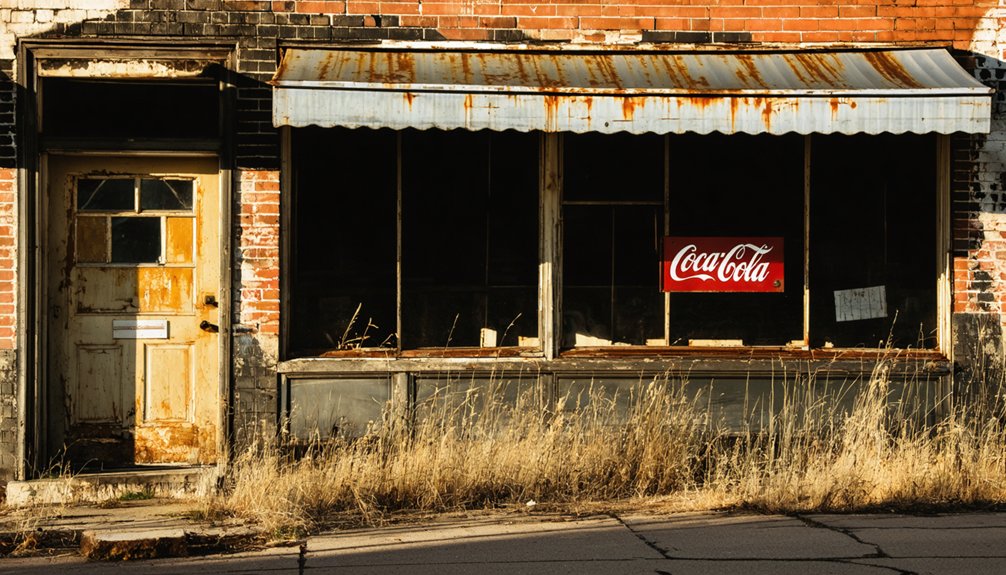You’ll find Griffin’s ghost town remnants between Marshall and Dennison in Illinois’ Wabash Township, where it thrived during the late 19th century. As an essential Illinois Central Railroad stop, the town supported 300-400 residents through its lumber yards, tanneries, and the Griffin Wheel Company. While industrial decline eventually emptied the settlement, abandoned tannery buildings and railroad traces still mark the landscape, preserving stories of this once-bustling industrial powerhouse.
Key Takeaways
- Griffin was established during the 19th-century Illinois railroad expansion and peaked with 300-400 residents during its industrial prominence.
- The town’s economic foundation relied on lumber, tanning operations, and the Griffin Wheel Company’s railway manufacturing.
- Resource depletion in the lumber industry and closure of tanneries triggered the town’s economic decline and population loss.
- Industrial buildings were abandoned after traditional manufacturing methods became outdated, leading to Griffin’s ghost town status.
- The town’s remains serve as a historical reminder of Clark County’s industrial past and railroad-driven development.
The Birth of a Railroad Settlement
How did a small settlement in Clark County, Illinois transform into a bustling railroad town?
You’ll find Griffin’s origins deeply rooted in the dynamic railroad expansion of the 19th century, when the Illinois Central Railroad was revolutionizing transportation across the state.
Located strategically in Wabash Township between Marshall and Dennison, Griffin emerged as a crucial stop along the railway line.
The settlement patterns of the era followed the tracks, and Griffin was no exception.
As the Illinois Central grew to become the world’s longest railroad, communities like Griffin sprouted up to support the network’s operations.
The railroad employed both white and Negro firemen to operate its locomotives, establishing a diverse workforce in towns like Griffin.
You’d have found a community designed around rail transport activities, where workers maintained the lines, passengers made their connections, and freight moved through the developing Illinois countryside.
Lumber and Tanning: Economic Foundations
While many small railroad towns relied on a single industry, Griffin’s economic success stemmed from the synergy between its lumber and tanning operations.
You’ll find that during the town’s peak, with 300-400 residents, these interconnected industries formed the backbone of local employment and trade. The area’s rich forests provided essential resources for both lumber production and tanning processes, as sawmills transformed timber while the tannery used oak bark for leather making. The Rice Emery Company provided substantial employment opportunities for local workers through its tannery operations. Following patterns seen across the eastern United States, the town’s intensive logging practices led to rapid deforestation of the surrounding area.
- Griffin’s tannery ranked among the county’s largest, employing a significant portion of local workers
- Sawmills processed timber for both local use and regional commerce
- Natural forest resources supplied raw materials for both industries
- The town’s economy thrived on the mutual support between lumber and leather production, though this dependency ultimately contributed to its downfall
Life During Griffin’s Golden Years
Life in Griffin during its peak years centered around the bustling industrial operations that employed most of its 300-400 residents. You’d find workers heading to the sawmill and tannery each day, following the strict schedules that governed life in this small industrial town.
Community gatherings often took place at the local school, which served as both an educational center and social hub. You’d see family dynamics shaped by long workdays, with households adapting to the demanding industrial schedules. Similar to other Illinois towns, crime and violence became more prevalent during the Prohibition era.
While specific details about entertainment venues aren’t documented, you’d have found informal social networks thriving among neighbors and coworkers. The railroad connection kept the town linked to larger markets, while local businesses provided basic necessities for the hardworking population. Much like the town of Cardiff, Illinois, the community’s livelihood depended heavily on industrial work.
Despite the town’s modest size, you’d have experienced a tight-knit community focused on supporting its industrial workforce.
Railroad’s Role in Town Development
You’ll find Griffin’s very existence was sparked by the 1879 Chicago & State Line Extension Railway’s construction project through Indiana and Illinois.
As a passenger transportation hub after 1880, Griffin quickly became a crucial stopover point between Valparaiso, Indiana, and the Illinois state line. The town’s strategic location along the rail line attracted numerous freight-related businesses, including grain elevators and lumber yards, while providing steady employment through railroad operations and maintenance. In 1910, Griffin Wheel Company acquired 40 acres of land in the area for a new wheel foundry. The town was later renamed to honor E. P. Griffith, a prominent railroad surveyor who mapped the original rail section.
Train Line Construction Impact
As railroads began expanding across Madison County in the mid-19th century, Griffin’s strategic location near major rail lines shaped its transformation into an industrial hub. The town saw immense growth as pressure-poured wheels revolutionized rail transport durability in the region.
You’ll find that the Chicago & Alton Railroad’s construction in the 1830s, followed by the Terre Haute & Alton Railroad from 1852 to 1856, created powerful industrial growth drivers that revolutionized the region’s connectivity and commerce. By 1850, the nation had established 9,000 miles of track, enabling Griffin to tap into an extensive transportation network.
- Railroad expansion effects included increased land values and rapid population growth
- The town’s proximity to multiple rail lines attracted significant industrial investment
- Local manufacturing, especially iron wheel production, thrived due to enhanced market access
- The Illinois Central Railroad’s 1851 charter boosted agricultural and industrial development, strengthening Griffin’s economic potential
The extensive rail network transformed Griffin from a modest settlement into a bustling industrial center with national market reach.
Passenger Transportation Hub
While many Illinois towns served as railroad stops, Griffin emerged as a particularly essential passenger transportation nexus during the early 1900s, anchored by its architecturally striking Illinois Central Railroad depot built in 1903.
You’d find the brick and stone station, with its distinctive hipped roof, serving as more than just a transit point – it became the heart of community gatherings and commerce. The project’s construction required vacating Monroe Street, dramatically altering traffic patterns around the town square.
As passenger trends evolved, the depot adapted to serve both civilian travelers and military personnel heading to various conflicts.
The station’s strategic location reshaped Griffin’s layout, with streets realigned to accommodate the steady flow of passengers. Local businesses, including hotels and restaurants, sprouted around the depot, creating a vibrant commercial district that defined the town’s character through the mid-twentieth century.
Freight Industry Growth
Beyond its role as a passenger hub, Griffin’s explosive growth stemmed from the Illinois Central Railroad’s freight operations and the town’s pioneering wheel manufacturing industry.
The town’s strategic location along Illinois Central’s Y-shaped mainline made it an essential center for freight innovation, with Griffin Wheel Company leading rail economics through groundbreaking manufacturing advances.
- You’ll find Griffin Wheel’s production skyrocketed to 1 million wheels annually by 1906, meeting the booming freight industry’s demands.
- The company’s 1952 steel-controlled pressure pouring technology created wheels three times more durable than iron.
- Their 1964 parabolic deep-dish design revolutionized freight car performance and maintenance costs.
The synergy between rail component manufacturing and Illinois Central’s expanding freight network transformed Griffin into a thriving industrial powerhouse.
The Decline of Local Industries
You’ll find that Griffin’s economic downturn began with its once-thriving lumber industry, which suffered from depleted timber resources and fierce competition from larger operations outside the area.
The town’s prominent tannery, one of the county’s largest employers, couldn’t survive the emergence of new technologies and cheaper alternatives in the leather industry.
These industrial losses triggered a devastating chain reaction, as both the sawmills and tannery closures displaced workers and shuttered supporting businesses throughout Griffin.
Lumber Industry Fades Away
As lumber resources dwindled across Illinois between 1900 and 1923, Griffin’s once-thriving timber industry faced inevitable decline.
You’d have witnessed the dramatic alteration as lumber scarcity forced operations to relocate to the Northwest and Alaska, leaving local mills silent. The industrial shift wasn’t unique to Griffin – it reflected a broader pattern across the Midwest as forests depleted and new building materials gained popularity.
- Local timber processing plummeted as portable chainsaws made logging more efficient but couldn’t overcome resource depletion.
- Steel and concrete began replacing wood in construction projects, further reducing demand.
- Former lumber lands transformed into pastures and croplands.
- Some abandoned areas returned to forest, though these secondary growths couldn’t match the original timber stands.
The era of Griffin’s lumber-driven prosperity had come to an end, marking a permanent change in the town’s economic landscape.
Tanneries Close Their Doors
The closure of Griffin’s tanneries in the early 1900s dealt another blow to the town’s industrial base, mirroring the broader decline of leather production across Illinois. You’d have found these once-bustling facilities along Griffin’s riverfront, where workers processed hides using traditional oak bark methods before newer tannery innovations like chromium salts emerged elsewhere.
Environmental challenges played a decisive role in their shutdown. The tanneries’ discharge into local waterways had created mounting pollution concerns, and rising costs to meet stricter regulations proved too burdensome.
As synthetic materials gained popularity and traditional tanning skills became scarcer, Griffin’s leather industry couldn’t adapt. The abandoned tannery buildings stood as silent reminders of the town’s industrial heritage until their eventual demolition, leaving behind both environmental hazards and economic hardship for local families.
Remnants of a Forgotten Community
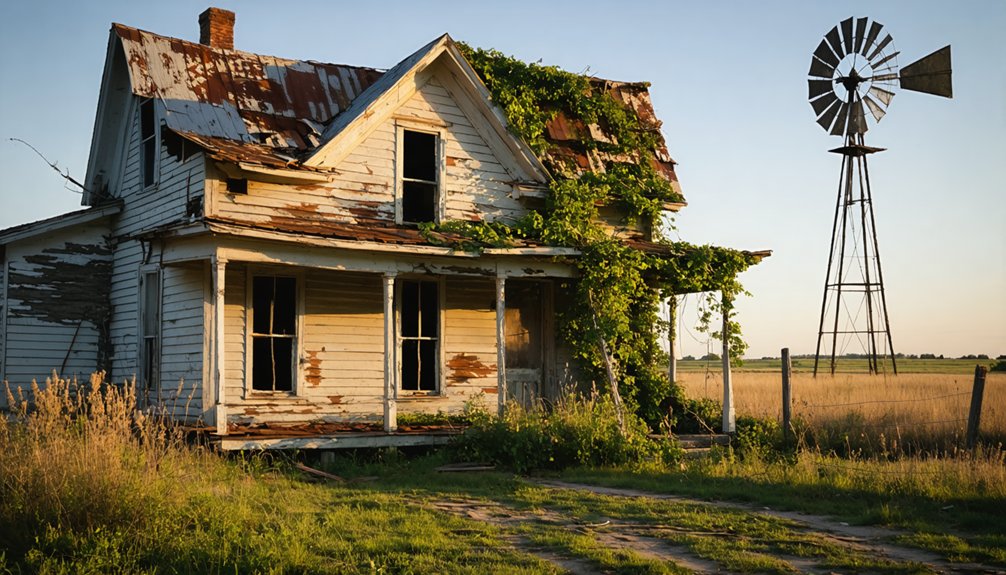
Despite the passage of time, virtually no original structures remain standing in what was once the bustling town of Griffin, Illinois. For urban exploration enthusiasts and those passionate about historical preservation, you’ll find the area haunting yet fascinating.
Today’s remnants tell the story of a community that once thrived but has since faded into obscurity. As you walk through the abandoned townsite, you’ll discover:
Time has erased Griffin’s glory, leaving only whispered memories in crumbling foundations and empty pathways.
- Foundation stones marking where homes and businesses once stood
- Scattered bricks and weathered timber from original buildings
- Old fence posts that once marked property boundaries
- Overgrown paths that were once busy streets
These silent witnesses to Griffin’s past serve as a stark reminder of how quickly a thriving community can disappear, leaving only traces for future generations to contemplate.
Griffin’s Legacy in Clark County
While many ghost towns dot Illinois’ landscape, Griffin’s influence on Clark County’s development remains particularly significant.
You’ll find its impact woven into the region’s economic and social fabric, where this once-thriving industrial hub employed up to 400 workers in its lumber and tanning operations.
Griffin’s story exemplifies both community resilience and the harsh realities of industrial decline.
The town’s strategic position along the Marshall-Dennison railroad line initially fueled its growth, but shifting economic patterns eventually led to its abandonment.
Today, historical preservation efforts, including documentation by local historians like Eliza Darling, guarantee that Griffin’s legacy lives on.
You can trace the town’s influence through Clark County’s changing demographics and settlement patterns, offering valuable insights into rural Illinois’ industrial heritage.
Exploring the Ghost Town Today
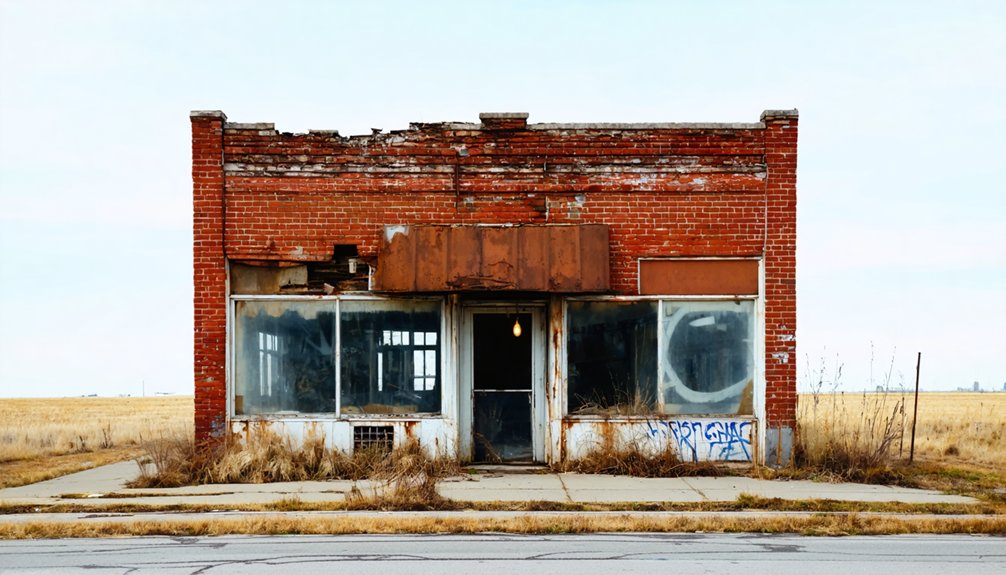
Visitors exploring Griffin today will find a hauntingly quiet landscape where nature has reclaimed most of this once-bustling Illinois settlement. During your urban exploration, you’ll encounter scattered historical artifacts like weathered fire hydrants and crumbling foundations that hint at the town’s former vibrancy.
The site’s accessibility requires navigation through rural backroads, and you’ll need to explore on foot due to limited vehicle access.
- Overgrown fields and natural prairie vegetation have replaced former streets and buildings
- No formal tours exist, so you’re free to discover the ghost town at your own pace
- Wildlife sightings often include deer, native birds, and small Midwestern mammals
- The nearby Illinois River provides context for the town’s original settlement and trade routes
Frequently Asked Questions
Were There Any Notable Crimes or Murders in Griffin’s History?
You won’t find documented crimes or murders in Griffin’s records, though local folklore hints at unexplained disappearances during the town’s industrial decline. Historical records remain sparse on this topic.
What Happened to the Original Residents After the Town’s Abandonment?
You’ll find the resident migration patterns are largely unknown, though most people likely moved to other industrial towns seeking work, leaving no documented town legacy behind them.
Did Any Famous People or Historical Figures Visit Griffin?
Ever wonder who might’ve stopped in this tiny railroad town? You won’t find any evidence of famous visitors or historical significance in Griffin – there’s no record of notable figures passing through.
Were There Any Schools or Churches Established in Griffin?
You’ll find evidence of a school during Griffin’s peak period, but specific school history details are scarce. There’s no confirmed church significance, as records don’t definitively show any religious establishments.
What Natural Disasters, if Any, Affected Griffin During Its Existence?
Unlike Noah’s flood or Dorothy’s twister, you won’t find records of major natural disasters in Griffin’s history. No documented tornado damage or flood impact exists in available historical sources.
References
- https://www.heraldtimesonline.com/story/lifestyle/home-garden/2021/01/15/some-illinois-ghost-towns/43846097/
- https://drloihjournal.blogspot.com/p/lost-towns-of-illinois-series.html
- https://www.northcountryatwork.org/archive-items/the-ghost-town-of-griffin/
- https://sangamoncountyhistory.org/wp/14696/
- https://www.youtube.com/watch?v=93k0qtvzkn4&vl=en-US
- http://genealogytrails.com/ill/jefferson/ghostowns.html
- https://drloihjournal.blogspot.com/2022/09/lost-towns-of-illinois-griffin-illinois.html
- https://en.wikipedia.org/wiki/List_of_ghost_towns_in_Illinois
- https://law.justia.com/cases/federal/district-courts/FSupp/88/552/1956681/
- https://dnrhistoric.illinois.gov/research/sitepages/timeline.html
